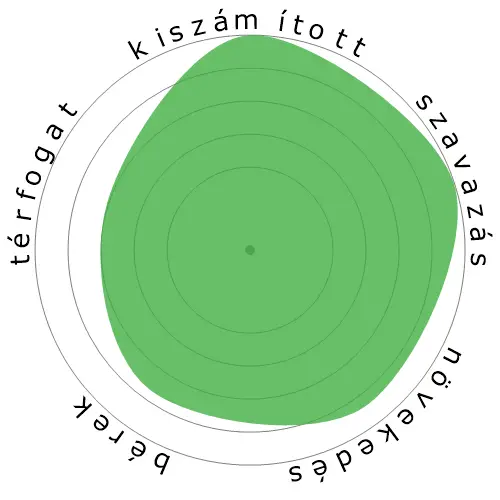Gyógytornászok




Az emberek ezt is megtekintették
Számított automatizálási kockázat
Minimális kockázat (0-20%): Ebben a kategóriában a foglalkozások automatizálásának alacsony a valószínűsége, mivel általában összetett problémamegoldást, kreativitást, erős interperszonális készségeket és magas manuális ügyességet igényelnek. Ezek a munkák gyakran bonyolult kézmozgásokat és precíz koordinációt igényelnek, ami megnehezíti a gépek számára a szükséges feladatok reprodukálását.
További információ arról, hogy mi ez a pontszám, és hogyan számítják ki, elérhető itt.
Felhasználói szavazás
A látogatóink szerint alacsony az esélye annak, hogy ezt a foglalkozást automatizálni fogják. Ezt az értékelést tovább erősíti a kiszámított automatizálási kockázati szint, amely 0,0% esélyt becsül az automatizálásra.
Mit gondol, milyen kockázatai vannak az automatizációnak?
Milyen valószínűséggel fogják Gyógytornászok robotok vagy mesterséges intelligencia helyettesíteni a következő 20 évben?
Érzelem
A következő grafikon mindenhol szerepel, ahol jelentős mennyiségű szavazat áll rendelkezésre, hogy értelmes adatokat lehessen megjeleníteni. Ezek a vizuális ábrázolások az időbeli felhasználói szavazási eredményeket mutatják, jelentős jelzést adva a hangulat trendjeiről.
Érzelem az időben (évente)
Növekedés
A(z) 'Physical Therapists' munkahelyi nyitások száma várhatóan 14,2%-kal nő 2033-ra.
Teljes foglalkoztatottság és becsült állásnyitások
A frissített előrejelzések 09-2025 időpontban esedékesek..
Bérek
A(z) 2023-ban a 'Physical Therapists' éves középfizetése 99 710 $ volt, vagyis 47 $ óránként.
'Physical Therapists' magasabb összeget kaptak, mint az országos mediánbér, ami 48 060 $-n állt.
Bérek az idők folyamán
Térfogat
2023 időpontjában 240 820 ember dolgozott 'Physical Therapists' munkakörben az Egyesült Államokban.
Ez körülbelül a 0,16% -át képviseli az országban foglalkoztatott munkaerőnek.
Másképp fogalmazva, körülbelül minden 630. ember 'Physical Therapists'-ként dolgozik.
Munkaköri leírás
Értékeljen, tervezzen, szervezzen és vegyen részt rehabilitációs programokban, amelyek javítják a mobilitást, enyhítik a fájdalmat, növelik az erőt, és javítják vagy korrigálják a betegségből vagy sérülésből eredő rokkantsági állapotokat.
SOC Code: 29-1123.00


Megjegyzések
Leave a comment
Big issue is one of liability. When the Pt does something incorrectly, or gets hurt doing something, who becomes liable?
Not possible in next 30 years.
The data you say will help us only.
Long answer - while I agree with the previous commenters that 'Someone needs to be there', who is that someone? Is it just a PT Assistant and a chatbot that comes up with the plans and the assistant guides the exercises? You need to consider reduction in job scale (thus salary) here not just elimination.
I say no overall because the way I think about it is people will pay for this service (mainly the care/psychological aspect and not just the exercises that they could find on google already). I have been in this situation myself. This isn't a fast food restaurant where people just want their food and don't care how it is made. I think if the therapist is good at the care, patient management, psychology, and any additional 'experience' aspects in addition to knowing the technical stuff they will be fine.
I am a physical therapist. We don't treat injuries based solely on reported impairments. We view each injury holistically. If AI can treat chronic pain patients better than us therapists, then that would be a nice day.
Plus, would you rather have a robot treating and instructing you to exercise? I don't think so. Physical therapists also face patients who are in their worst state. Imagine being treated by robots like Darth Vader. Yes, that might sound profitable for some hospitals, but ask any patient if they would like to be handled solely by robots.
We're not just patting your backs or asking you to lift some weights. We see you as more than just your back problem. We don't just zap or pat your backs.
Furthermore, in most health problems that physios treats, exercise is the most recommended intervention. And many exercises can be done without a professional supervision. This scenario could allow a patient to download an app that facilitates to conduct a self treatment.
If all physiotherapy was, was prescribing exercises, then it would definitely have a huge chance of being replaced by automation soon. Look at the field of radiology for a good example of this phenomenon—technology is getting exceedingly good at finding and diagnosing illnesses without human help. But the work physios do is diverse. Yes, prescribing exercises is a part of the job, but hands-on manual therapy is just as important. The variety of work within the field of physiotherapy is enormous as well. Physios may specialise in everything from working with athletes to patients with neurological disorders.
Physiotherapists undergo training in tangential fields, such as psychology, in order to be better able to understand their clients. After all, the goal is really to help patients in the best possible manner! Great physios also act as psychologists, guiding their patients through the mental challenges of rehabilitation and overcoming injury or illness (which may take place over the course of several months). Just like in occupational therapy (physiotherapy's sister), human-to-human interaction is a huge part of the job. This isn't something that can be replaced by a robot, at least not easily...
You never know fifty, one hundred years down the line. Just look at the difference between 2020 and 1970, 2020 and 1920. Honestly though, physiotherapy is absolutely safe considering the current situation of technological development. It will be one of the fastest growing, in-demand occupations in the next few decades.
Hagyjon egy választ erről a foglalkozásról